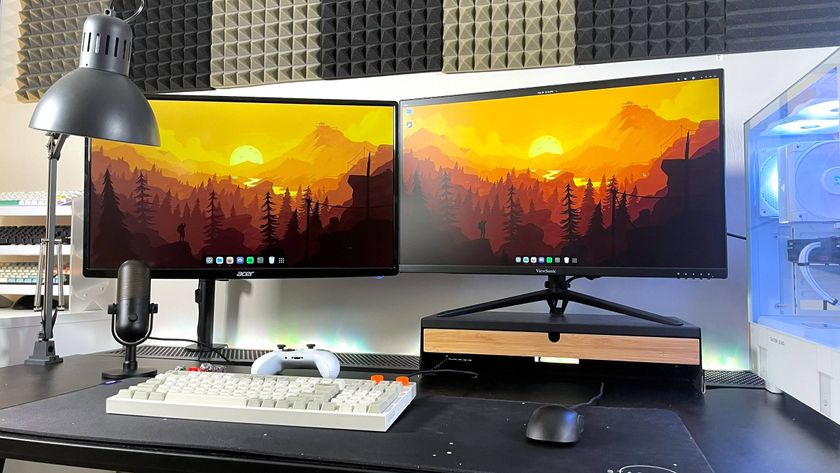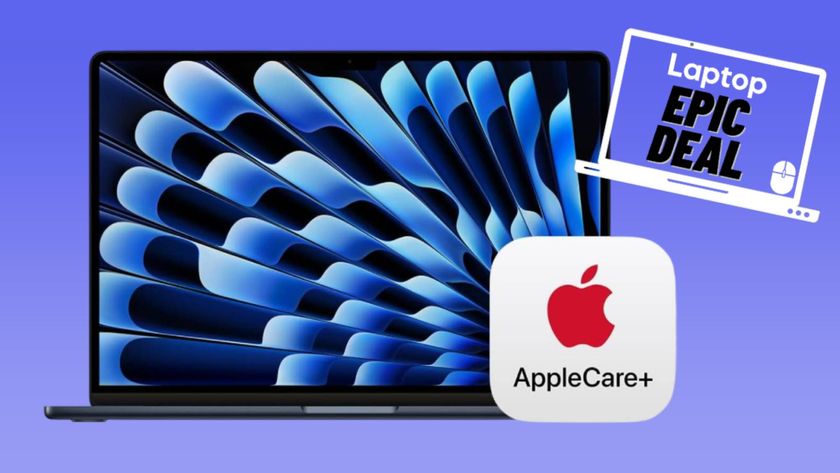Laptop Mag Verdict
The Razer Blade 14 is comfortably seated at the intersection of portability and power, offering excellent graphics and gaming performance with an ultra-high-res display in a slim, lightweight chassis.
Pros
- +
Portable, sexy design
- +
Stunning, 3200 x 1800 display
- +
Excellent overall and graphic performance
- +
Comfortable keyboard
Cons
- -
Expensive
- -
Runs incredibly hot
- -
Below-average battery life
Why you can trust Laptop Mag
In the words of wrestling legend Ric Flair, "To be the man, you gotta beat the man." If the latest Razer Blade 14 is any indication, the competition has ways to go to take the belt. Where most slim gaming notebooks accept sacrifices to make weight, Razer refuses to compromise on what matters -- performance. The $2,399 laptop offers powerful overall and graphic performance with a beautiful, 3200 x 1800 display wrapped in the same slim, black chassis that turned the gaming industry on its head when after debuting in 2013. Your move, notebook industry.
Design
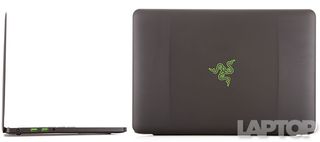
Whoever said "familiarity breeds contempt" surely has never laid eyes on the Blade 14. Three iterations later, the all-black aluminum chassis with the glowing, green tri-snake emblem continues to titillate. The subtle pair of lines running horizontally down the lid gives the impression of a sleek yet powerful luxury car, enticing you to put the key in the ignition. Vroom, vroom, baby.
The interior is just as thrilling, with the familiar full-sized keyboard glowing an ethereal emerald green, nestled between a pair of speakers. A lone black power button sits serenely above the F7 button.
MORE: Find the Best Gaming Laptop for You
There is however, a slight difference from previous generations. Measuring 4.4 pounds and 13.6 x 9.3 x 0.7-inches, the 2014 edition of the Blade 14 is a little thicker and heavier than the first two versions, which each measured 4.2 pounds and 13.6 x 9.3 x 0.66 inches. The Lenovo Y40, which also weighs 4.4 pounds, is chunky by comparison, at 13.7 x 9.9 x 0.9 inches.
The MacBook Pro 15-inch Retina (2013) is just a hair behind the new Blade, at 4.5 pounds and 14.1 x 9.7 x 0.71-inches. Thanks to its magnesium-lithium undercarriage, the thicker, 15.4 x 10.5 x 0.78-inch MSI GS60 Ghost still weighs a light 4.2 pounds.
Display
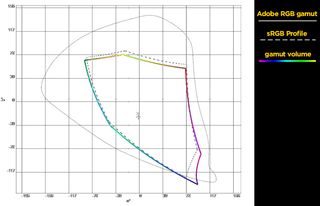
Click to EnlargeLooking to quell complaints about the previous Blade's 1600 x 900 display, Razer put its money where its mouth is and outfitted the latest version with a 3200 x 1800 retina-like touch-screen panel. I was impressed by the screen's vivid color and crisp detail ... until I placed it next to my MacBook Pro 15 with Retina.
Despite the lower, 2880 x 1800 resolution, my 15-inch MacBook Pro with Retina beat the Blade on both fronts. When I looked at an image of an American bald eagle on both panels, the Blade delivered more-realistic hues, complete with white head-feathers flecked with subtle hints of gold and brown. However, my eye kept coming back to the MacBook with its borderline-oversaturated golds and browns. The tongue hanging out of the bird's disturbing maw was a fleshy pink.
The MacBook was the clear winner on details, delivering crisp definition between the individual feathers. The most impressive detail came in the tiny flecks we noticed in the bird's iris. These same details were present on the Blade, but some of the finer points of the image were not as clear.
When I watched the 4K Interstellar trailer with a colleague, we noted that the MacBook had better contrast, which translates into deeper blacks. The Blade delivered warmer color overall, producing brighter explosions billowing with plumes of white, orange and yellow.
Castlevania: Lords of Shadow - Ultimate Edition looks stunning on the Blade's 3200 x 1800 panel. My hero's red coat billowed out gracefully while I scaled a humongous titan. As I reached for handholds during my ascent, I couldn't help but admire the intricate stone etchings adorning the creature's stone-gray body. Crushing a weak point on the titan's frame rewarded me with a luminous blast of turquoise that willed me onto victory.
The Blade delivered strong performance when it was tested for color capability, hitting 101.5 percent on the sRGB color gamut scale, surpassing the 77.4 percent thin-and-light average. The Ghost wasn't far behind, at 98 percent, while the MacBook Pro notched 94.9 percent.
During the Delta-E test, which measures color accuracy, the Blade hit 1.5, which isn't a perfect 0, but pretty impressive considering the 7.7 average. Once again, the Ghost placed second with 2.9, but the MacBook Pro eked out the win with a score of 1.4.
The Blade produced an average of 261 nits during the brightness test, topping the 219-nit average. However, the MacBook Pro hit 277 nits, and the GS60 Ghost was the brightest in the land, at 299 nits.
I'm not a fan of gaming notebooks with touch-screen displays, but the Blade's 10-point capacitive screen was swift and responsive.
Audio
Audio on the Blade is a mixed bag, as it delivered loud, boisterous playback that tended to be treble heavy. I winced a little when listening to Marvin Gaye's "After the Dance." The opening horns were tinny and distorted at maximum volume. That's easily remedied by adjusting the volume, though.
However neither a volume adjustment nor the preinstalled Dolby software could fix the overcrowded vocals. Gaye's sweet tenor was the best part of the track, but the background vocals sounded flat by comparison.
The top-mounted speakers fared better when I started playing Castlevania: Lords of Shadow - Ultimate Edition. Voiced by Robert Carlyle, the character Gabriel's tortured, tired brogue was full and gorgeous. Details such as the scraping of metal against stone had the appropriate grating effect. As I cut a path through hordes of vampires, lycans and zombies, I never tired of hearing my blade hacking away and drawing screams of dismay.
The Blade is a bit of a loudmouth, hitting 88 decibels on the Laptop Mag Audio test, topping the 81-dB average. The Ghost was a few levels behind, at 84 dB.
Keyboard/Touchpad

Click to EnlargeThey aren't mechanical keys, but I'll take them. The Blade's island-style keyboard offers firm, springy feedback. The key travel was measured at 1.4mm, which falls below the typical range of 1.5-2 mm. However, it takes 60 grams of force to press the keys down, which confirms the strong feedback I experienced. Because of the tactile feel, I hit 60 words per minute on the Ten Thumbs Typing test, which is higher than my usual 55 wpm.
The eerie, green, backlit keyboard is a showstopper, and I appreciated seeing the keys power down when not in use. You can customize the lighting to a small degree via the Razer Synapse 2.0, by setting the brightness level. It doesn't hold a candle to what you can do with an Alienware system, but it's something.
MORE: The Best Gaming Keyboards You Can Buy
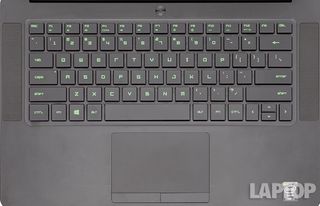
Click to EnlargeThe 4.1 x 2.5-inch Synaptics touchpad is massive for such a petite notebook. And the bigger, the better. I had plenty of room to glide my fingers along the smooth, plastic surface, easily performing pinch-zoom, three-finger press and two-finger rotate. I had the same experience with Windows 8.1 gestures, swapping through open apps in smooth, seamless motion.
The discrete mouse buttons are still on the skinny side. However, both inputs have bouncy feedback and perform their left- and right-button mouse duties well.
Razer Synapse 2.0

Click to EnlargeMost PC gamers have experience setting up macros. I, for one, have a hate-hate relationship with the process. Recording intricate keystrokes and commands to specific keys can be time-consuming, especially for MMORPG titles, and it cuts into valuable gaming time.
Razer's Synapse 2.0 software cuts out some of the pain, letting gamers create macro profiles for various titles that can be accessed on any notebook that has the software, including Macs. Profiles for peripherals such as the Razer BlackWidow Ultimate keyboard or the Naga Mouse can be accessed, but profiles and macros created for the notebook are off limits.
I used the cloud-based configuration software to create a custom profile for World of Warcraft, cobbling together a macro that unleashed two abilities simultaneously and another that helped me quickly switch targets.
After entering all the necessary commands and hitting save, I mapped the new macros to the keyboard, created a new profile for WoW and was ready to start questing anew. In addition to gaming, you can also map keys for other uses. I mapped the four direction-keys with commands to launch the Charms Menu, switch among profiles, close apps and show the desktop respectively.
You can customize the lighting to a small degree, by setting the brightness level. It doesn't hold a candle to what you can do with an Alienware system, but it's something.
Heat
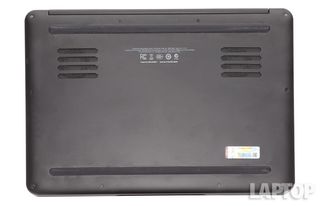
Click to EnlargeIs it hot in here, or is it just the Blade 14? After streaming a full-screen Hulu video for 15 minutes, the touchpad measured 87 degrees Fahrenheit. The space between the G and H keys hit 96 degrees, just past the 95-degree comfort threshold. The laptop's undercarriage measured 101 degrees with the back edge hitting an uncomfortable 108 degrees.
Things really started cooking when I played Castlevania: Lords of Shadow - Ultimate Edition. After 15 minutes, the touchpad jumped to 97 degrees, while the space between the G and H keys measured 113 degrees. Along the bottom of the notebook, I recorded a reading of 125 degrees in the space between the two fans. Temperatures above 95 degrees uncomfortable and those above 100 really bad.
If you like white noise, you'll love the Blade 14. When the notebook got particularly hot, I was able to hear its fans very clearly. They're not turbine-loud, but it's definitely noticeable.
Webcam

Click to EnlargeColor on the Blade's integrated 1080p webcam isn't as vibrant as I expected. My co-worker's golden plaid shirt looked two shades darker, and the colors in my own rainbow plaid shirt also looked washed out, especially the reds and pinks.
The camera managed to deliver a fair amount of detail. I could easily read the white text on the water bottle in the background of the shot. It also successfully captured the frizziness near the front of my scalp.
Ports
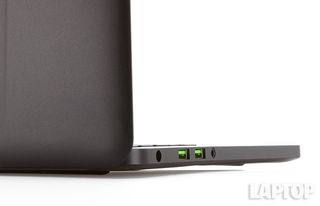
Click to EnlargeYou won't find too many ports on the Blade. There's a USB 3.0 port, HDMI and a Kensington lock on the right, with another pair of USB 3.0 ports, a headset jack and the power port on the left.
Graphics and Gaming
The updated Razer Blade 14 might not be the thinnest or the lightest, but it's certainly one of the most powerful slim gaming rigs on the market. Thanks to its Nvidia GeForce GTX 870M GPU with 3GB of VRAM, the laptop can play most of the more graphically intensive titles on the market at the highest settings no problem.
When I played Castlevania: Lords of Shadow - Ultimate Edition at a glorious 3200 x 1800 with the special effects turned to high, the Blade didn't break a sweat (I did, however, thanks to the laptop's blistering temperatures). At these settings, the Blade delivered smooth gameplay at 45 fps, even when I was beating back a horde of lycans and undead creatures.
The notebook relies on its integrated Intel HD Graphics 4600 GPU to handle less-taxing tasks such as streaming video, surfing the Web or working in Google Docs.
When we tested its overall graphics performance, the Blade 14 scored 113,793, which is double the 56,022 thin-and-light average. The MSI GS60 Ghost's Nvidia GeForce GTX 860M GPU was a close second, at 113,571.
MORE: Top Gaming Mice 2014
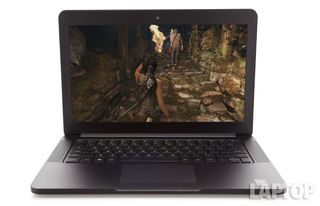
Click to EnlargeAt its native resolution (3200 x 1800) on autodetect settings in World of Warcraft, the Blade hit 100 fps, sailing past the 24 fps average. The MacBook Pro 15 (Nvidia GeForce GT 750M) notched 49 fps at 2880 x 1620. When switched to high, the Blade delivered 65 fps, surpassing the 38 fps average and the MacBook's 25 fps.
In the BioShock Infinite benchmark test, the Blade 14 achieved 120 fps on low at 1080p, easily surpassing the 49 fps average and the Ghost's score of 91 fps. The Blade continued to impress when the settings were cranked to high, delivering 51 fps, which shattered the 20 fps average. The GS60 notched 35 fps.
When our testing team took off the kid gloves and ran the Metro: Last Light benchmarks, the Blade 14 crushed the 38-fps category average and the GS60 (53 fps) by hitting 70 fps on low at 1080p. The Blade's frame rate dropped to 19 fps on high settings, which was more than enough to best the 8-fps category average and the Ghost's mark of 12 fps. At native resolution, the Blade achieved 35 fps on low, which is below the 41-fps average but above the 30 fps it needed to be playable. The notebook finally met its match when we switched the special effects to high, as the Blade delivered 8 fps and just missed the 10-fps average.
Performance
The Razer Blade 14's strong performance isn't confined to gaming. Equipped with a 2.2-GHz Intel Core i7-4702HQ CPU with 8GB of RAM, the notebook can just as easily serve as a lean, mean productivity machine. Without missing a beat, the laptop streamed an episode of Hemlock Grove on Netflix while performing a full-system scan with 13 open tabs in Google Chrome, Mozilla Firefox and Internet Explorer.
The Blade achieved 11,497 on Geekbench 3, a synthetic test that measures overall performance. This is more than double the 5,686 thin-and-light average. The MacBook Pro's 2.3-GHz Intel Core i7 CPU edged out the Blade, with a score of 11,928; meanwhile, the MSI GS60 Ghost (2.4-GHz Intel Core i7-4700HQ) came out on top, with 12,695.
It took only 10 seconds for the Blade's 256GB SSD to boot Windows 8.1, which is much faster than the 18-second average. The Ghost (128GB mSATA SSD with 1TB 7,200-rpm hard drive) was right on the Blade's heels, finishing in 11 seconds. The MacBook's 256GB Flash Drive loaded OS X 10.9 (Mavericks) in 15 seconds.
MORE: 8 Worst Windows 8 Annoyances and How to Fix Them
During the File Transfer test, the Blade copied 4.97GB of multimedia files in 33 seconds for a transfer rate of 154.2MBps. It beat the 99.8MBps average and the GS60 Ghost's 91MBps, but the MacBook was the ultimate winner, with a screaming 196MBps.
On the Spreadsheet Macro test, the Blade paired 20,000 names and addresses in 4 minutes and 15 seconds, topping the 6:46 average. The MacBook Pro was only a second faster, at 4:14, while the Ghost finished first, with a time of just 4 minutes flat.
Battery Life
The Razer Blade lasted 5 hours and 19 minutes on the Laptop Mag Battery test, continuously surfing the Web over Wi-Fi at 100 nits (19 percent brightness for this laptop), short of the 7:24 thin-and-light average. The Ghost tapped out at 5:34.
Running on the older Laptop Mag Battery Test (continuous Web surfing over Wi-Fi at 40 percent brightness), the MacBook Pro lasted 8:57.
MORE: 10 Laptops with the Longest Battery Life
Software and Warranty
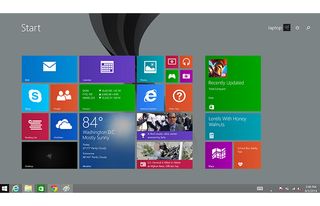
Click to EnlargeAside from Razer Synapse 2.0 and the usual cast of Windows 8.1 apps (Mail, Skype, OneDrive and Calendar), the Blade 14 is refreshingly free of bloatware. That leaves you free to fill the notebook with things that truly matter -- games.
Configurations
The $2,399 model of the Razer Blade 14 I tested comes configured with a 2.2-GHz Intel Core i7-4702HQ CPU, 8GB of RAM, a 256GB SSD, Nvidia GeForce GTX 870M GPU with 3GB of VRAM and an Intel HD Graphics 4600 GPU.
The base model is not that much cheaper, at $2,199, and gives you all the same specs, but bumps the storage down to 128GB. The high-end (higher-end?) model bumps the SSD up to 512GB and costs $2,699. It's enough to make most wallets scream for mercy.
Bottom Line
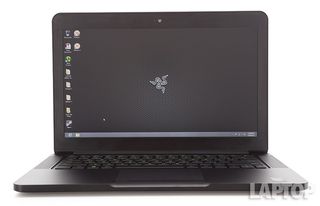
Click to EnlargeAfter three iterations, Razer continues to lead the charge on what a true portable gaming notebook should be. The $2,399 Blade 14 is a near-perfect merging of power and portability, delivering the sleek, sexy chassis I've come to know and love, with enough oomph to knock competitors on their arses. And the 3200 x 1800 display is a sight to behold.
However, the Razer Blad 14 suffers from searing temperatures, below-average battery life and a budget-demolishing price tag. For $1,699, you can get the MSI GS60 Ghost, which is lighter and runs cooler, but has a lower-resolution display, a less-attractive chassis and slightly-weaker performance overall. However if you have the money (along with an arm, leg and a firstborn) to spare, the Razer Blade 14 is the Ferrari of gaming notebooks: fast, sexy and just a little bit dangerous.
Razer Blade 14 (2014) Specs
| Bluetooth | Bluetooth 4.0 |
| Brand | Razer |
| CPU | 2.2-GHz Intel Core i7-4702HQ |
| Company Website | www.razerzone.com |
| Display Size | 14 |
| Graphics Card | Nvidia GeForce GTX 870M/Intel HD Graphics 4600 |
| Hard Drive Size | 256GB |
| Hard Drive Speed | n/a |
| Hard Drive Type | SSD Drive |
| Native Resolution | 3200 x 1800 |
| Operating System | Windows 8.1 |
| Optical Drive | None |
| Optical Drive Speed | n/a |
| Ports (excluding USB) | security lock slot, USB 3.0, Headset, HDMI |
| RAM | 8GB |
| Size | 13.6 x 9.3 x 0.7 inches |
| Touchpad Size | 4.1 x 2.5 inches |
| USB Ports | 3 |
| Video Memory | 3GB |
| Weight | 4.4 pounds |
| Wi-Fi | 802.11a/b/g/n/ac |
| Wi-Fi Model | Intel Wireless-AC 7260HMW |

Sherri L. Smith has been cranking out product reviews for Laptopmag.com since 2011. In that time, she's reviewed more than her share of laptops, tablets, smartphones and everything in between. The resident gamer and audio junkie, Sherri was previously a managing editor for Black Web 2.0 and contributed to BET.Com and Popgadget.

